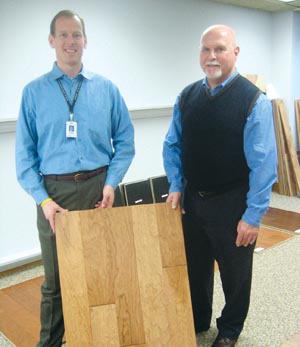 |
| Mannington's John Himes, left & Stuart Beatie |
|
Hicksville, N.Y.—Despite all the publicity and marketing, many people still equate engineered wood flooring as being mainly a West Coast type of product or a lower-quality floor than its solid brethren. But these perceptions could not be farther from the truth as the overall trend in sales and construction bares out.
Engineered floors were originally created to give builders the ability to glue a wood floor on top of concrete without fear of it warping or buckling. While this basic concept still exists in parts of the country, the realization that this kind of product has the potential to offer numerous advantages over the traditional solid that have been used since the first wood floors were made.
This coupled with an explosion of desire by consumers to have real wood in their homes and a dwindling supply of a natural resource kicked the industry’s research and development machine into full gear.
Now, today’s engineered wood floors may carry the same manufacturing name as their predecessors they in no way have any resemblance in terms of styling, performance, durability, etc.
Depending on who is asked the engineering segment accounts for 40% to 50% of the total category with no signs of slowing down. Consumers across the country are recognizing its value-added attributes, and more and more companies are producing these types of products.
In fact, many mills only manufacture engineered floors. Those who do both are starting to offer more of the engineered variety than of the solid.
There are numerous reasons for this. For example, “The strength and performance of engineered wood in excellent,” noted Glen Miller, national sales manager of Perverco and chairman of the technical education committee for the
National Wood Flooring Association. “In fact, the engineering process can actually create a wood product that exhibits greater strength than natural wood.”
Chris Thompson, vice president of sales and marketing for Mirage, noted what started out as a three-ply cross-grain construction has now been expanded to five- and even seven-ply. “There has been all types of developments that have enhanced the product’s overall performance and appearance.
On the performance side, John Himes, director of
Mannington Mills’ hardwood business, said engineered is no longer confined to just glue-down installation on concrete slab. “Our hardwoods can now be installed using a variety of methods—glue-down, staple, nail or float. The installer will select the best method based on the type and condition of the subfloor and the type of floor being installed. Plus, they offer the utmost in flexibility in where they can used. Unlike solids, they can be installed below, on and above grade, as well as over radiant heat because the cross-grain construction makes it much more stable.”
In recent years, a number of mills are producing engineered floors with a mechanical locking system similar to what is found on laminates, thus eliminating the glue, nails and staples.
“Engineered flooring has broadened how and where it can be installed,” added Thompson. “Another advantage is, it’s thinner than solids so it is perfect for replacement/remodel jobs as there are less problems with appliances and doorways. The transition is also easier going to other flooring surfaces.”
Miller agreed. “There is no need for trim or reducers. It’s a blessing, especially for the condo market. We try to get builders to use it in areas where there could be problems, such as with radiant heat or in some of today’s new homes which are air tight.”
Performance has also improved on wearlayers, an area Miller credits laminate for helping out. “They showed you can walk on paper. We now have the same types of wearlayers but on wood.”
“Both solids and engineered have seen advances in this area,” Thompson said, but they just add to the engineered product’s various advantages, such as Mirage’s Nanolinx technology (FC-News, Jan. 23/30). It’s very durable and makes maintenance so easy that if followed correctly the floor can last a lifetime.”
Also, while wearlayers are extremely tough, the sawn face process means an engineered wood can actually be sanded, whereas in the past that was limited only to solids.
On the appearance side, advances in processing the wood has helped create a more realistic look. “Products were originally rotary peeled,” Thompson said. “That’s still going on, but many mills like Mirage have gone to a hand sawn face process which gives the look of a real solid.
“We can now create looks you just won’t find anywhere else,” Himes noted. “We can take a piece of hickory and create a time worn, rustic look that would be a real drawback for most consumers if we had to use real barn beams or old farmhouse floors. It would be cost prohibited.”
The increased cost of timber has also been a factor in the shift to engineered wood, such as with the growing desire for exotic species whose supply is dwindling as more forests get protection status.
“Engineered floors are made in a way that effectively uses more of each log,” Himes said.
“You can certainly take the same amount of lumber and go further than a solid,” Thompson agreed.
Just how much? Miller said it could be four to five times. “On average, one tree will produce 2,000 square feet of engineered wood as opposed to only 500 of other products. It’s a huge advantage.”
Overall, Thompson noted, most dealers understand the benefits of engineered wood but there is still a perception among consumers who, despite being more educated than ever, are not fully informed. “They still feel thicker is better and that is not the case with engineered versus solid. Retailers can overcome this by being more knowledgeable and showing and explaining to consumers the advantages of engineered.”
“There are so many options,” concluded Miller, “from being user-friendly to durable to stylish. Show me a negative—I can’t see one, so long as it is manufactured properly and installed correctly.”
—Matthew Spieler